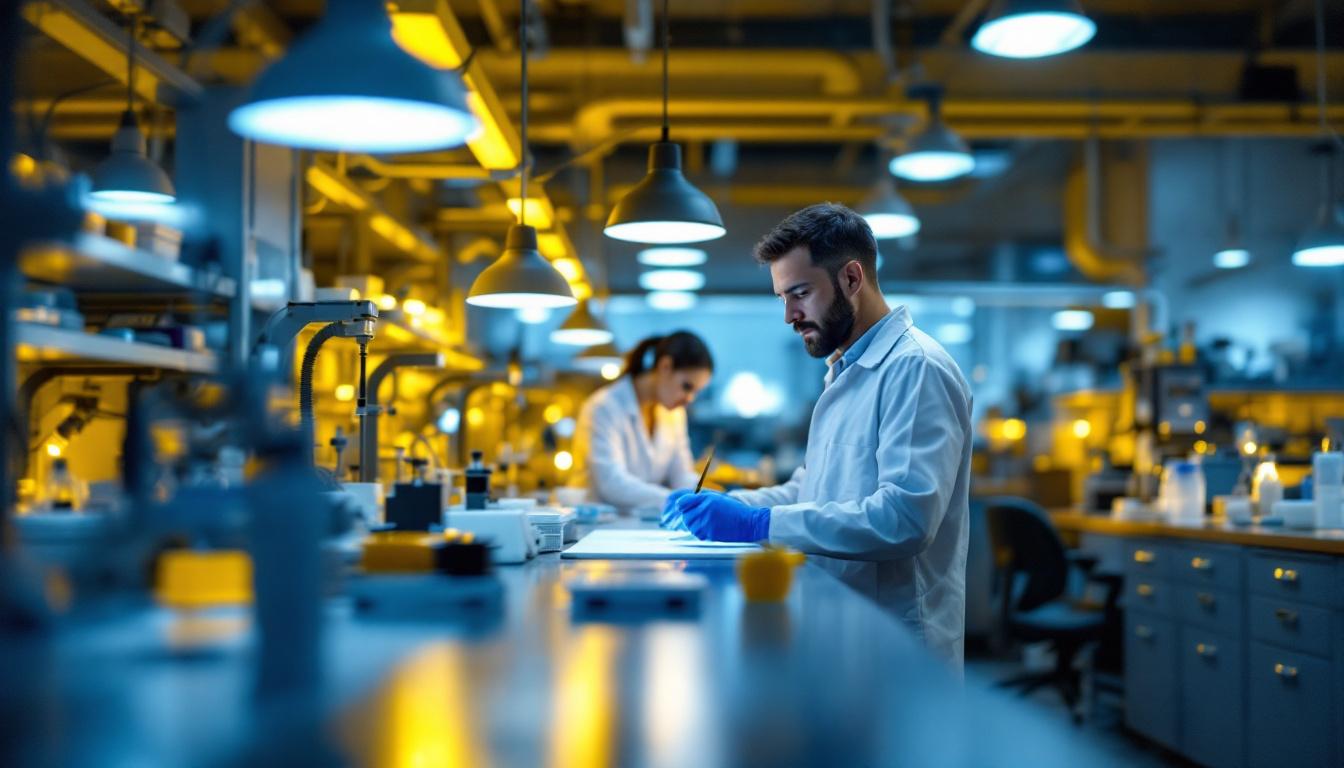
Lighting plays a crucial role in laboratory environments, impacting everything from safety to productivity. For lighting contractors, understanding the unique requirements of laboratory lighting is essential. This article delves into the significance of laboratory lighting, the challenges faced, and the best practices for creating effective lighting solutions tailored to laboratory settings.
Laboratories are specialized environments where precision and accuracy are paramount. Proper lighting not only enhances visibility but also influences the overall functionality of the space. For lighting contractors, recognizing the importance of suitable lighting solutions is the first step toward delivering high-quality installations.
One of the primary reasons laboratory lighting is critical is safety. Laboratories often involve the handling of hazardous materials, delicate instruments, and intricate procedures. Adequate lighting helps prevent accidents, ensuring that all tasks are performed safely. Moreover, many laboratories must comply with strict regulations regarding lighting standards. Failure to meet these standards can result in penalties and compromise the integrity of the research conducted.
Lighting contractors must be well-versed in these regulations to provide compliant solutions. This includes understanding the necessary illumination levels for various lab activities, such as microscopy, chemical analysis, or biological experimentation. By ensuring that lighting meets or exceeds these requirements, contractors can help laboratories maintain a safe working environment. Additionally, the use of motion sensors and automatic dimming features can further enhance safety by ensuring that lights are only on when needed, reducing the risk of accidents in areas where visibility is critical.
In addition to safety, proper lighting significantly impacts productivity and accuracy. Inadequate lighting can lead to eye strain, fatigue, and decreased focus, all of which can hinder a laboratory worker’s ability to perform tasks efficiently. By providing well-designed lighting systems that offer appropriate brightness and color temperature, lighting contractors can create environments that foster concentration and enhance performance.
Moreover, specific tasks may require different lighting conditions. For instance, tasks involving color matching or detailed visual inspections benefit from high Color Rendering Index (CRI) lighting. Understanding these nuances allows contractors to tailor their lighting solutions to meet the specific needs of laboratory personnel, ultimately leading to better outcomes in research and experimentation. Furthermore, the integration of adjustable lighting systems can empower lab workers to customize their work environment according to their preferences, which can lead to increased job satisfaction and improved overall morale. This adaptability is particularly important in collaborative lab settings where multiple tasks are performed simultaneously, and individual lighting needs may vary significantly.
Designing lighting for laboratories comes with its own set of challenges. Lighting contractors must navigate various factors that can complicate the process. These challenges include the need for flexibility, the integration of advanced technologies, and the management of energy efficiency.
Laboratories are dynamic environments where layouts and functions can change frequently. As research evolves, so too do the lighting requirements. Lighting contractors must design systems that can adapt to these changes without significant overhauls. This may involve using modular lighting systems or adjustable fixtures that allow for easy reconfiguration.
Additionally, the ability to control lighting levels in different areas of the lab is essential. For example, a section dedicated to detailed analysis may require brighter lighting, while another area focused on sensitive experiments may benefit from dimmable options. Providing flexible solutions ensures that laboratories can maintain optimal lighting conditions as their needs evolve. Furthermore, the incorporation of task lighting can enhance productivity by allowing researchers to focus light precisely where it is needed, minimizing glare and shadows that could hinder meticulous work.
Modern laboratories increasingly rely on advanced technologies, such as automation and smart systems. Lighting contractors must be adept at integrating these technologies into their designs. This includes using sensors that adjust lighting based on occupancy or natural light levels, as well as implementing smart controls that allow users to customize their lighting environment.
By leveraging technology, contractors can create energy-efficient lighting solutions that not only reduce operational costs but also enhance the overall user experience. Understanding how to incorporate these technologies effectively is crucial for lighting contractors aiming to stay competitive in the industry. For instance, integrating IoT (Internet of Things) capabilities can enable real-time monitoring and adjustments, ensuring that the lighting system operates at peak efficiency while providing data analytics that inform future design decisions.
Energy efficiency is a significant concern for many laboratories, particularly those looking to reduce their environmental footprint. Lighting contractors must consider energy-efficient solutions that provide adequate illumination without excessive energy consumption. This often involves selecting LED fixtures, which offer long lifespans and lower energy usage compared to traditional lighting options.
Additionally, contractors should be knowledgeable about energy codes and standards that apply to laboratory lighting. By designing systems that meet these criteria, contractors can help laboratories achieve their sustainability goals while also benefiting from potential cost savings. Moreover, the implementation of daylight harvesting strategies, which utilize natural light to supplement artificial lighting, can further enhance energy efficiency. This approach not only reduces reliance on electric lighting but also creates a more pleasant working environment, contributing to the well-being and productivity of laboratory personnel.
To create effective laboratory lighting solutions, contractors should follow best practices that address the unique needs of these environments. This includes conducting thorough assessments, collaborating with stakeholders, and staying informed about industry trends.
Before designing a lighting system, contractors should conduct a comprehensive assessment of the laboratory space. This involves evaluating the layout, identifying specific tasks performed in each area, and understanding the needs of laboratory personnel. By gathering this information, contractors can make informed decisions about lighting types, placements, and controls.
Additionally, considering factors such as the color of walls, ceiling heights, and the presence of windows can influence lighting design. A well-rounded assessment ensures that the final lighting solution is tailored to the laboratory’s unique requirements, enhancing both safety and functionality. For example, bright white lighting may be beneficial in areas where precision work is conducted, while softer lighting could be more appropriate for relaxation zones or break rooms. Moreover, the integration of adjustable lighting systems can allow for flexibility, enabling users to modify light levels based on specific tasks or personal preferences, thereby improving overall productivity.
Effective laboratory lighting design requires collaboration with various stakeholders, including laboratory managers, researchers, and safety officers. Engaging these individuals early in the design process allows contractors to gain insights into specific needs and preferences. This collaborative approach can lead to more successful outcomes and greater satisfaction among users.
Furthermore, involving stakeholders in the decision-making process fosters a sense of ownership and encourages adherence to the new lighting system. By ensuring that the final design aligns with the expectations of those who will be using the space, contractors can enhance the overall effectiveness of their solutions. Regular feedback sessions during the implementation phase can also help identify any issues early on, allowing for timely adjustments. Additionally, providing training on how to best utilize the new lighting features can empower laboratory personnel, ensuring they feel confident and comfortable in their work environment, which ultimately contributes to enhanced safety and efficiency.
The field of laboratory lighting is continually evolving, with new technologies and best practices emerging regularly. Lighting contractors must stay informed about these trends to provide cutting-edge solutions. This includes attending industry conferences, participating in training programs, and engaging with professional organizations.
By remaining current with advancements in lighting technology, contractors can offer innovative solutions that meet the evolving needs of laboratory environments. This commitment to ongoing education not only enhances the contractor’s expertise but also positions them as a trusted resource for clients. For instance, the rise of smart lighting systems that utilize IoT technology allows for real-time monitoring and adjustments based on occupancy and ambient light levels, significantly improving energy efficiency. Additionally, understanding the implications of color temperature on human productivity and well-being can guide contractors in selecting the most appropriate lighting options, thereby creating a more conducive atmosphere for research and experimentation. As sustainability becomes increasingly important, being knowledgeable about energy-efficient lighting solutions can also provide a competitive edge, appealing to environmentally conscious clients looking to reduce their carbon footprint.
Laboratory lighting is a critical component that directly influences safety, productivity, and compliance. For lighting contractors, understanding the unique requirements of laboratory environments is essential for delivering effective solutions. By recognizing the importance of proper lighting, addressing the challenges of design, and adhering to best practices, contractors can create environments that support the vital work conducted in laboratories.
As the demand for advanced laboratory facilities continues to grow, the role of lighting contractors becomes increasingly significant. By embracing innovation, collaborating with stakeholders, and prioritizing energy efficiency, contractors can ensure that their lighting solutions not only meet current needs but also anticipate future developments in laboratory design.
In summary, the importance of laboratory lighting cannot be overstated. For lighting contractors, mastering this specialized field is not just about providing illumination; it is about enhancing the overall functionality and safety of laboratory environments, ultimately contributing to the success of scientific research and innovation.
Ready to elevate your laboratory lighting installations with the highest quality products at the best value? Look no further than LumenWholesale. Our spec-grade lighting selection is designed to meet the rigorous demands of laboratory environments, ensuring safety, productivity, and compliance. With unbeatable wholesale prices and the convenience of free shipping on bulk orders, LumenWholesale is your go-to source for premium lighting without the premium price tag. Don’t let middleman markups dim your project’s potential. Discover the best in wholesale lighting at LumenWholesale and make your next lighting project shine.

Discover how a 4 foot fluorescent bulb impacts lighting contractors’ projects, offering energy efficiency, cost savings, and improved illumination—boost your expertise today!.

Discover how undercabinet lighting can transform your space with enhanced illumination and style.

Discover how light ceilings are revolutionizing the lighting industry, offering contractors innovative solutions for enhanced aesthetics and energy efficiency.

Discover the essential do’s and don’ts for lighting contractors when purchasing stadium lights.